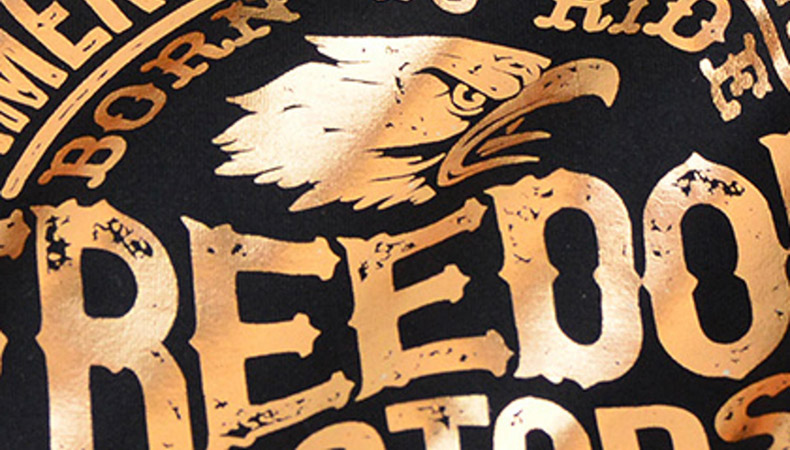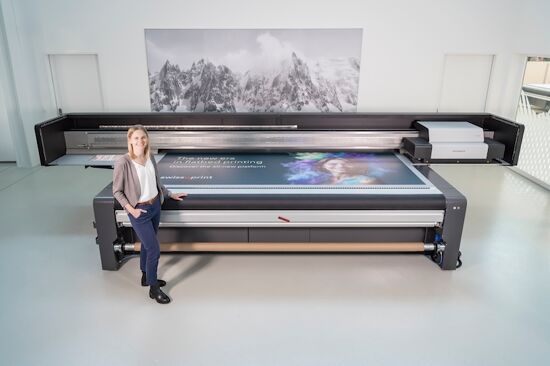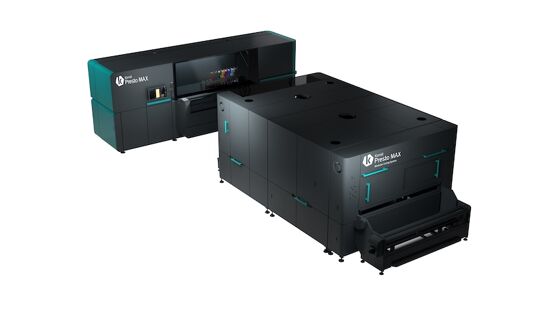Transfer printing vs Foil cutting - what technique should you invest in?

There are many ways to decorate t-shirts and other apparel. Transfer printing and foil cutting are the most common techniques used. Sonja Angerer discusses which technology is best suited for which applications, which tools are needed and what printers should consider when investing.
Whether it is sporting events, graduation parties, work wear: printed shirts are among the constant favourites of digital printers and sign makers. But customers are becoming more demanding. Today, it is not possible to achieve premium margins with a shirt with a simple inscription in a standard font anymore. Transfer and plotter foils are often used for apparel decoration, they offer printers many premium options.
The variety available with Transfer printing
Transfer foil is a popular method that allows individual and creative designs on any kind of apparel. The desired motif is printed on a special film, which is then transferred to the garment with an iron or a heat press.
Transfer films for water-based inks
The simplest form of apparel decoration works with transfer foils for water-based inks with pigment or dye formulations. They are suitable for any textile surfaces and may be used with almost any standard printer, even most desktop office models.
The motif is printed mirror-inverted and fixed in the heat press at medium pressure and approximately 200°C in less than 30 seconds. There are transparent films for white and light substrates available, as well as white coated substrates for dark and brightly coloured textiles. The motifs need be prepared with a simple outline to avoid weeding.
Transfer films for water-based inks are particularly suitable for fast turnaround apparel, as they usually will not work well with a household washing machine, and the film typically hardens or tears when the item is worn. These films are usually sold as sheets at very affordable prices.
 CAPTION: “No Cut” film for OKI WT printers have become very popular in recent years. Image Credit: Karl Gröner GmbH
CAPTION: “No Cut” film for OKI WT printers have become very popular in recent years. Image Credit: Karl Gröner GmbH
Transfer printing with sublimation inks
Typical sublimation printers, e.g. from Epson, Mimaki, Mutoh or Roland DG, use transfer paper in rolls or sheets. There are also special films available for apparel printing. The standard process requires a shirt with a high polyester content or a polyester coating. That's why transfer printing is mainly used for sportswear. For the best results, the unprinted shirt should be white or very light in colour.
Since the printing ink absorbs completely into the fibre during transfer when fixated in a calendar or hot press, the textile feel is retained, and items are easily cleaned in a washing machine. Desktop sublimation printers are available for less than 1,000 euros. There are many items available primed for the sublimation process, for example caps, cups or mouse pads, though an optional heat press base plate may be required.
Transfer foils with solvent-based inks
Transfer foils for eco-solvent ink are available for light and dark textiles. Most films for transfer printing with solvent-based ink will work only with polyester, but there are also options suitable for cotton and leather. Motifs can be manually cut with scissors, a cutting plotter or a printer with a contour cut function (Print & Cut). The transfer temperature in the hot press is roughly 180°C, and the shirt must be fixated for approximately 30 seconds. Eco-solvent inks can also be used to print on special flock films, which can then be further processed like any other heat-transferred flock film.
Transfer film for laser printers
Transfer films for toner printers have grown enormously popular in recent years, especially laser transfer films for OKI WT toners.
"The 2-sheet Laser-Dark (No-Cut) system makes it possible to print specific colours. Time-consuming cutting and weeding are outdated. The A-Foil is printed with the desired motif and pressed with the B-Paper Pro next. The white layer of the B-Paper enhances the opacity and luminosity of the colours on dark textiles and improves their adhesion for greater durability and even more wash resistance," explains Frank Klein-Hitpass, Business Unit Manager Promotional Textiles/Textile Transfer Films at Karl Gröner GmbH.
Apparel decorated with transfer films for toner-based printers can be washed at up to 40 degrees but should not be put in a tumble dryer. Since there are also transfer films available for office laser printers, moving into the technology does not require big investment.
 CAPTION: Personalised high-gloss metal effects are only possible with films. Image Credit: Karl Gröner GmbH
CAPTION: Personalised high-gloss metal effects are only possible with films. Image Credit: Karl Gröner GmbH
Foil cut: The sign technology staple
Textile films for cutting plotters are a staple of advertising technology, with cutting plotters introduced into the market in the early 1980s when vinyl letters were mainly used for vehicle decoration and signage. In the process, a knife cuts through the coloured foil, which remains on the liner ("kiss-cut"). Today's films for apparel printing work almost identically, but they are mainly polyester based. They will work on cotton as well as polyester.
Almost any letter or shape can be plotted, if it is available as a vector data. Any part of the film that cannot go onto the fabric needs to be removed by hand ("weeding"), which can be very time-consuming depending on the motif.
Films for cutting plotters usually do not get printed onto, as they often are specialties such as high-gloss metal, neon, or glitter. Printers can achieve effects like specialty screen printing, so posterised and logo motives are common with the technology. Film fixation requires a heat press, usually at 160°C, and will usually take less than 20 seconds.
“The flex and flock films have developed significantly over time, especially in the last 10 years, and meet today's demand for a wide selection for different substrates, processing technologies and durability. Flex and flock films are very durable and can withstand many washes at 60°C. Especially for beginners, finishing with flex and flock films is very interesting due to the low costs for a cutting plotter and a heat press,” says Klein-Hitpass.
He continues: “All Gronal Flex & Flock films are Oekotex Standard 100 certified. Most of them are classified according to class 1 and are therefore also safe for babies and toddlers. In addition, many Gronal transfer films are vegan certified.”
 CAPTION: A hot press is needed for fixating printed and plotter-cut films. Image Credit: S. Angerer
CAPTION: A hot press is needed for fixating printed and plotter-cut films. Image Credit: S. Angerer
Should you invest in transfer printing or film cutting?
If you want to get into printing T-shirts and other garments, it does not require large investment, no matter what technology chosen. Desktop devices for transfer printing are available for just a few hundred euros, and a small plotter for rolls or single sheets is also very affordable.
However, printers should be aware of the quality of the hot press they invest in, as it is needed for printed transfer as well as film cutting. With base plates heating unevenly or not able to retain the temperature, film gets damaged in the process or will peel off the fabric, leading to customer dissatisfaction.
Foil cutting with colour and effect foils can be used to create designs that are not possible with digital printing and are time-consuming or too expensive for screen printing for short runs, thus creating opportunities for premium margin. A large selection of films will take up a great amount of space and creates a significant amount of waste of release liner and weeding leftovers.
Most apparel printing businesses therefore use a wide range of technologies as required, including printed transfer, "No Cuts" and coloured plotted film, providing their customers with the perfect decoration option for any project.
Klein Hitpass comments: "The demand for effect films Glitter, Pearl, Metallic and 3D has increased significantly in recent years. We have greatly expanded the range of different GRONAL films and the choice of colours in the Gröner range. We also see this as a growth market for the future."
Interested in joining our community?
Enquire today about joining your local FESPA Association or FESPA Direct
Recent news

The importance of ink for large format printers
Ink is crucial for large format inkjet printers, influencing substrate compatibility, productivity, and cost. Nessan Cleary discusses the three main types which include UV-curable ink, latex ink and eco-solvent ink. Each ink type has specific strengths and weaknesses, making printers choice dependent on budget and intended applications.

What are the benefits of Direct-To-Fabric printing?
Direct-to-fabric printing is gaining popularity for high-volume textile production, enabling on-demand, customized short runs. These printers offer ink flexibility, accommodating various fabric types like cotton and silk, though ink development focuses on faster turnaround by reducing pre- and post-processing. Compared to traditional methods, direct-to-fabric inkjet printing is a more sustainable option due to reduced water and chemical usage, and localized production.

What are the opportunities for large format providers regarding digital touch screens?
Digital touchscreens are becoming increasingly common, offering businesses opportunities to improve customer engagement and streamline operations. Nessan Cleary shares, while more expensive to implement than standard digital displays due to complex software and integration needs, touchscreens provide self-service options, multilingual support, and can reduce staffing costs in various settings like retail, transportation, and healthcare.
